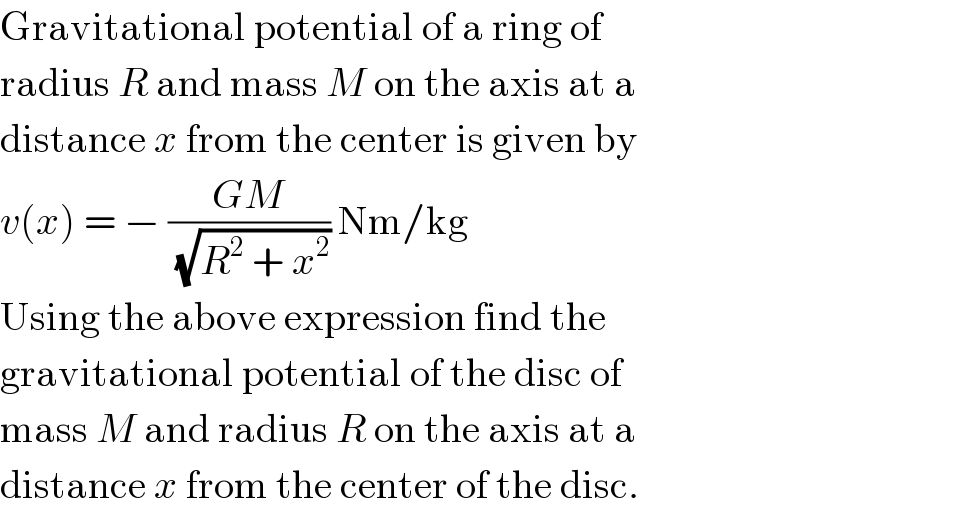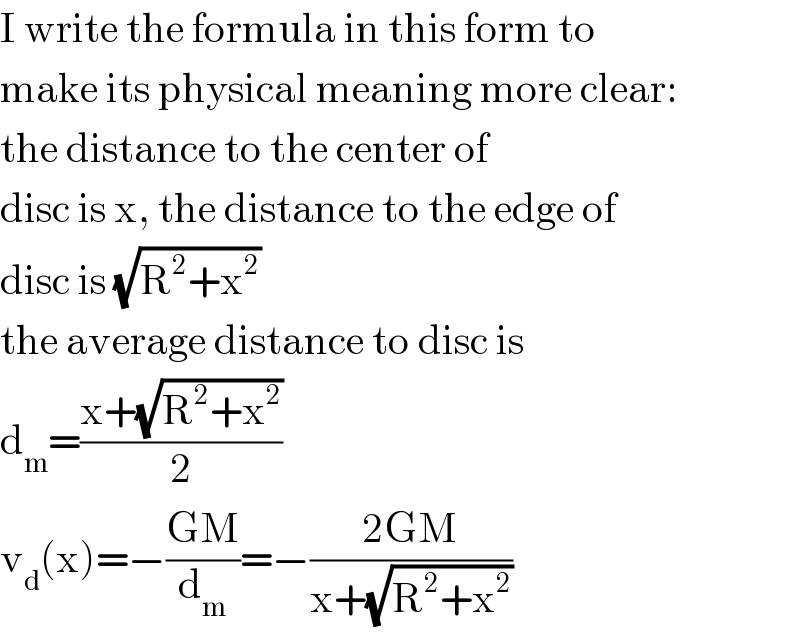
Question Number 15052 by Tinkutara last updated on 07/Jun/17

$$\mathrm{Gravitational}\:\mathrm{potential}\:\mathrm{of}\:\mathrm{a}\:\mathrm{ring}\:\mathrm{of} \\ $$$$\mathrm{radius}\:{R}\:\mathrm{and}\:\mathrm{mass}\:{M}\:\mathrm{on}\:\mathrm{the}\:\mathrm{axis}\:\mathrm{at}\:\mathrm{a} \\ $$$$\mathrm{distance}\:{x}\:\mathrm{from}\:\mathrm{the}\:\mathrm{center}\:\mathrm{is}\:\mathrm{given}\:\mathrm{by} \\ $$$${v}\left({x}\right)\:=\:−\:\frac{{GM}}{\sqrt{{R}^{\mathrm{2}} \:+\:{x}^{\mathrm{2}} }}\:\mathrm{Nm}/\mathrm{kg} \\ $$$$\mathrm{Using}\:\mathrm{the}\:\mathrm{above}\:\mathrm{expression}\:\mathrm{find}\:\mathrm{the} \\ $$$$\mathrm{gravitational}\:\mathrm{potential}\:\mathrm{of}\:\mathrm{the}\:\mathrm{disc}\:\mathrm{of} \\ $$$$\mathrm{mass}\:{M}\:\mathrm{and}\:\mathrm{radius}\:{R}\:\mathrm{on}\:\mathrm{the}\:\mathrm{axis}\:\mathrm{at}\:\mathrm{a} \\ $$$$\mathrm{distance}\:{x}\:\mathrm{from}\:\mathrm{the}\:\mathrm{center}\:\mathrm{of}\:\mathrm{the}\:\mathrm{disc}. \\ $$
Commented by Tinkutara last updated on 07/Jun/17

Commented by Tinkutara last updated on 07/Jun/17
![But answer is ((−2M)/R^2 )[(√(R^2 + x^2 )) − x]](Q15060.png)
$$\mathrm{But}\:\mathrm{answer}\:\mathrm{is}\:\frac{−\mathrm{2}{M}}{{R}^{\mathrm{2}} }\left[\sqrt{{R}^{\mathrm{2}} \:+\:{x}^{\mathrm{2}} }\:−\:{x}\right] \\ $$
Commented by mrW1 last updated on 07/Jun/17
![((−2GM)/R^2 )[(√(R^2 + x^2 )) − x] =((−2GM)/R^2 )[(√(R^2 + x^2 )) − x]×(([(√(R^2 +x^2 ))+x])/((√(R^2 +x^2 ))+x)) =((−2GM)/R^2 )[R^2 + x^2 − x^2 ]×(1/((√(R^2 +x^2 ))+x)) =−((2GM)/((√(R^2 +x^2 ))+x))](Q15068.png)
$$\frac{−\mathrm{2G}{M}}{{R}^{\mathrm{2}} }\left[\sqrt{{R}^{\mathrm{2}} \:+\:{x}^{\mathrm{2}} }\:−\:{x}\right] \\ $$$$\:=\frac{−\mathrm{2G}{M}}{{R}^{\mathrm{2}} }\left[\sqrt{{R}^{\mathrm{2}} \:+\:{x}^{\mathrm{2}} }\:−\:{x}\right]×\frac{\left[\sqrt{\mathrm{R}^{\mathrm{2}} +\mathrm{x}^{\mathrm{2}} }+\mathrm{x}\right]}{\sqrt{\mathrm{R}^{\mathrm{2}} +\mathrm{x}^{\mathrm{2}} }+\mathrm{x}} \\ $$$$\:=\frac{−\mathrm{2G}{M}}{{R}^{\mathrm{2}} }\left[{R}^{\mathrm{2}} \:+\:{x}^{\mathrm{2}} \:−\:{x}^{\mathrm{2}} \right]×\frac{\mathrm{1}}{\sqrt{\mathrm{R}^{\mathrm{2}} +\mathrm{x}^{\mathrm{2}} }+\mathrm{x}} \\ $$$$\:=−\frac{\mathrm{2GM}}{\sqrt{\mathrm{R}^{\mathrm{2}} +\mathrm{x}^{\mathrm{2}} }+\mathrm{x}} \\ $$
Commented by Tinkutara last updated on 07/Jun/17

$$\mathrm{Thanks}\:\mathrm{Sir}! \\ $$
Answered by ajfour last updated on 07/Jun/17
![dv=−((GdM)/(√(r^2 +x^2 )))=−((G(σ)(2πrdr))/(√(r^2 +x^2 ))) v =−πσG∫_0 ^( R) (((2rdr)/(√(r^2 +x^2 )))) =−πσG[2(√(r^2 +x^2 )) ]_(r=0) ^(r=R) =−2πσG((√(R^2 +x^2 ))−R) =−2πG((M/(πR^2 )))((√(R^2 +x^2 ))−R) v(x)_(disc) =−((2GM)/R^2 )((√(R^2 −x^2 ))−R) .](Q15058.png)
$$ \\ $$$${dv}=−\frac{{GdM}}{\sqrt{{r}^{\mathrm{2}} +{x}^{\mathrm{2}} }}=−\frac{{G}\left(\sigma\right)\left(\mathrm{2}\pi{rdr}\right)}{\sqrt{{r}^{\mathrm{2}} +{x}^{\mathrm{2}} }} \\ $$$$\:\:\:{v}\:=−\pi\sigma{G}\int_{\mathrm{0}} ^{\:\:{R}} \left(\frac{\mathrm{2}{rdr}}{\sqrt{{r}^{\mathrm{2}} +{x}^{\mathrm{2}} }}\right) \\ $$$$\:\:\:\:\:\:=−\pi\sigma{G}\left[\mathrm{2}\sqrt{{r}^{\mathrm{2}} +{x}^{\mathrm{2}} }\:\right]_{{r}=\mathrm{0}} ^{{r}={R}} \\ $$$$\:\:\:\:\:\:=−\mathrm{2}\pi\sigma{G}\left(\sqrt{{R}^{\mathrm{2}} +{x}^{\mathrm{2}} }−{R}\right)\: \\ $$$$\:\:\:\:\:\:=−\mathrm{2}\pi{G}\left(\frac{{M}}{\pi{R}^{\mathrm{2}} }\right)\left(\sqrt{{R}^{\mathrm{2}} +{x}^{\mathrm{2}} }−{R}\right) \\ $$$$\:\:\:{v}\left({x}\right)_{{disc}} \:=−\frac{\mathrm{2}{GM}}{{R}^{\mathrm{2}} }\left(\sqrt{{R}^{\mathrm{2}} −{x}^{\mathrm{2}} }−{R}\right)\:. \\ $$
Commented by Tinkutara last updated on 07/Jun/17

$$\mathrm{Thanks}\:\mathrm{Sir}! \\ $$
Answered by mrW1 last updated on 07/Jun/17
![m=(M/(πR^2 )) [kg/m^2 ] v_d (x)=−G∫_0 ^R ((m2πrdr)/(√(r^2 +x^2 )))=−((GM)/R^2 )∫_0 ^R ((2rdr)/(√(r^2 +x^2 ))) =−((GM)/R^2 )∫_0 ^R (dr^2 /(√(r^2 +x^2 ))) =−((2GM)/R^2 )[(√(r^2 +x^2 ))]_0 ^R =−((2GM)/R^2 )[(√(R^2 +x^2 ))−x] =−((2GM)/R^2 )[(√(R^2 +x^2 ))−x]×(([(√(R^2 +x^2 ))+x])/([(√(R^2 +x^2 ))+x])) =−((2GM)/(x+(√(R^2 +x^2 ))))](Q15059.png)
$$\mathrm{m}=\frac{\mathrm{M}}{\pi\mathrm{R}^{\mathrm{2}} }\:\left[\mathrm{kg}/\mathrm{m}^{\mathrm{2}} \right] \\ $$$$\mathrm{v}_{\mathrm{d}} \left(\mathrm{x}\right)=−\mathrm{G}\int_{\mathrm{0}} ^{\mathrm{R}} \:\frac{\mathrm{m2}\pi\mathrm{rdr}}{\sqrt{\mathrm{r}^{\mathrm{2}} +\mathrm{x}^{\mathrm{2}} }}=−\frac{\mathrm{GM}}{\mathrm{R}^{\mathrm{2}} }\int_{\mathrm{0}} ^{\mathrm{R}} \frac{\mathrm{2rdr}}{\sqrt{\mathrm{r}^{\mathrm{2}} +\mathrm{x}^{\mathrm{2}} }} \\ $$$$=−\frac{\mathrm{GM}}{\mathrm{R}^{\mathrm{2}} }\int_{\mathrm{0}} ^{\mathrm{R}} \frac{\mathrm{dr}^{\mathrm{2}} }{\sqrt{\mathrm{r}^{\mathrm{2}} +\mathrm{x}^{\mathrm{2}} }} \\ $$$$=−\frac{\mathrm{2GM}}{\mathrm{R}^{\mathrm{2}} }\left[\sqrt{\mathrm{r}^{\mathrm{2}} +\mathrm{x}^{\mathrm{2}} }\right]_{\mathrm{0}} ^{\mathrm{R}} \\ $$$$=−\frac{\mathrm{2GM}}{\mathrm{R}^{\mathrm{2}} }\left[\sqrt{\mathrm{R}^{\mathrm{2}} +\mathrm{x}^{\mathrm{2}} }−\mathrm{x}\right] \\ $$$$=−\frac{\mathrm{2GM}}{\mathrm{R}^{\mathrm{2}} }\left[\sqrt{\mathrm{R}^{\mathrm{2}} +\mathrm{x}^{\mathrm{2}} }−\mathrm{x}\right]×\frac{\left[\sqrt{\mathrm{R}^{\mathrm{2}} +\mathrm{x}^{\mathrm{2}} }+\mathrm{x}\right]}{\left[\sqrt{\mathrm{R}^{\mathrm{2}} +\mathrm{x}^{\mathrm{2}} }+\mathrm{x}\right]} \\ $$$$=−\frac{\mathrm{2GM}}{\mathrm{x}+\sqrt{\mathrm{R}^{\mathrm{2}} +\mathrm{x}^{\mathrm{2}} }} \\ $$
Commented by mrW1 last updated on 07/Jun/17

$$\mathrm{I}\:\mathrm{write}\:\mathrm{the}\:\mathrm{formula}\:\mathrm{in}\:\mathrm{this}\:\mathrm{form}\:\mathrm{to} \\ $$$$\mathrm{make}\:\mathrm{its}\:\mathrm{physical}\:\mathrm{meaning}\:\mathrm{more}\:\mathrm{clear}: \\ $$$$\mathrm{the}\:\mathrm{distance}\:\mathrm{to}\:\mathrm{the}\:\mathrm{center}\:\mathrm{of} \\ $$$$\mathrm{disc}\:\mathrm{is}\:\mathrm{x},\:\mathrm{the}\:\mathrm{distance}\:\mathrm{to}\:\mathrm{the}\:\mathrm{edge}\:\mathrm{of} \\ $$$$\mathrm{disc}\:\mathrm{is}\:\sqrt{\mathrm{R}^{\mathrm{2}} +\mathrm{x}^{\mathrm{2}} } \\ $$$$\mathrm{the}\:\mathrm{average}\:\mathrm{distance}\:\mathrm{to}\:\mathrm{disc}\:\mathrm{is}\: \\ $$$$\mathrm{d}_{\mathrm{m}} =\frac{\mathrm{x}+\sqrt{\mathrm{R}^{\mathrm{2}} +\mathrm{x}^{\mathrm{2}} }}{\mathrm{2}} \\ $$$$\mathrm{v}_{\mathrm{d}} \left(\mathrm{x}\right)=−\frac{\mathrm{GM}}{\mathrm{d}_{\mathrm{m}} }=−\frac{\mathrm{2GM}}{\mathrm{x}+\sqrt{\mathrm{R}^{\mathrm{2}} +\mathrm{x}^{\mathrm{2}} }} \\ $$
